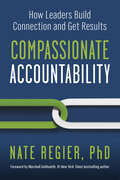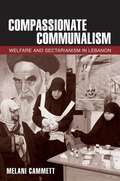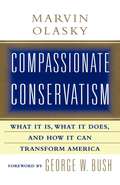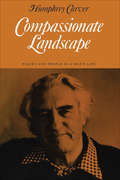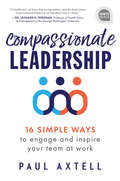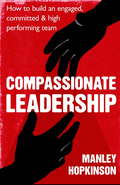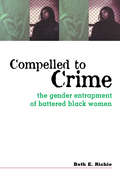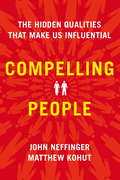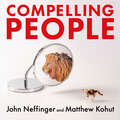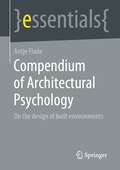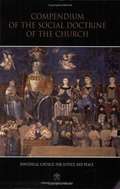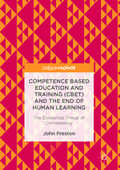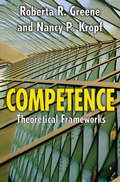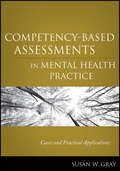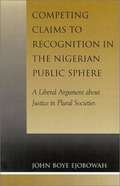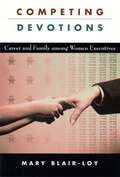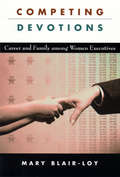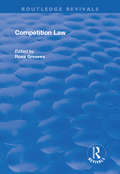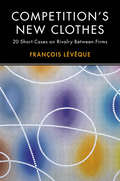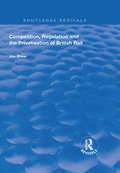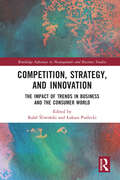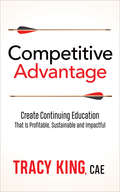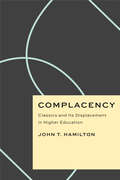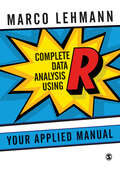- Table View
- List View
Compassionate Accountability: How Leaders Build Connection and Get Results
by Nate Regier PhDA compass for leaders lost in the paradoxical space between attention to people and attention to results—with Compassionate Accountability you don't have to choose! Sadly, compassion and accountability are too often in tension-leaders feel they have to pick one or the other. But solely prioritizing accountability can create toxic work environments that drive away good talent. On the other end of the spectrum, being too nice can compromise performance and productivity.Finding harmony between compassion and accountability is the ultimate catalyst for improved results and a thriving workplace. The solution is recognizing that compassion and accountability are not opposites. In fact, accountability is an element of compassion. Compassionate Accountability is the process of building connection while getting results. This book shows how this foundational mindset, philosophy, and way of living can lead to a thriving organizational culture. It covers such topics as these: Why you can't practice compassion without accountabilityHow to turn on the three switches of the compassion mindset—and the predictable damaging consequences when they're turned offThe key role Compassionate Accountability plays in a healthy leadership culture Six areas to focus on to start building your culture of Compassionate AccountabilityFive common barriers to compassion for leaders—and how to overcome themPlus, readers will find real case examples of how organizations have adopted Compassionate Accountability, along with quizzes and self-assessments to help them learn and apply the concepts. Leaders seeking a renewed sense of fulfillment in their roles and increased leadership impact will find inspiration, guidance, and a road map for cultural transformation.
Compassionate Communalism: Welfare and Sectarianism in Lebanon
by Melani CammettIn Lebanon, religious parties such as Hezbollah play a critical role in providing health care, food, poverty relief, and other social welfare services alongside or in the absence of government efforts. Some parties distribute goods and services broadly, even to members of other parties or other faiths, while others allocate services more narrowly to their own base. In Compassionate Communalism, Melani Cammett analyzes the political logics of sectarianism through the lens of social welfare. On the basis of years of research into the varying welfare distribution strategies of Christian, Shia Muslim, and Sunni Muslim political parties in Lebanon, Cammett shows how and why sectarian groups deploy welfare benefits for such varied goals as attracting marginal voters, solidifying intraconfessional support, mobilizing mass support, and supporting militia fighters.Cammett then extends her arguments with novel evidence from the Sadrist movement in post-Saddam Iraq and the Bharatiya Janata Party in contemporary India, other places where religious and ethnic organizations provide welfare as part of their efforts to build political support. Nonstate welfare performs a critical function in the absence of capable state institutions, Cammett finds, but it comes at a price: creating or deepening social divisions, sustaining rival visions of the polity, or introducing new levels of social inequality.Compassionate Communalism is informed by Cammett's use of many methods of data collection and analysis, including Geographic Information Systems (GIS) analysis of the location of hospitals and of religious communities; a large national survey of Lebanese citizens regarding access to social welfare; standardized open-ended interviews with representatives from political parties, religious charities, NGOs, and government ministries, as well as local academics and journalists; large-scale proxy interviewing of welfare beneficiaries conducted by trained Lebanese graduate students matched with coreligionist respondents; archival research; and field visits to schools, hospitals, clinics, and other social assistance programs as well as political party offices throughout the country.
Compassionate Conservatism
by Marvin OlaskyCompassionate conservatism is a new political force in the land, sweeping the grassroots of people of all faiths, races, and ethnicities. In its parts it offers solutions to many of our most intractable problems; in its whole it is nothing less than an innovative philosophy of government. No author is more qualified to explain its power and promise than Marvin Olasky, described by The New York Times as "the godfather of compassionate conservatism." Compassionate conservatism offers a new paradigm for how the government can and should intervene in the economy. It begins with a long-lost premise about human behavior: economics, by itself, is not what changes lives. Only faith, and deeply held beliefs, can do that. For decades government has focused only on material well-being, ignoring the passions and convictions that make life worth living. What is conservative about the new movement is that its leaders also know that government cannot instill these beliefs. What it can do is help them flourish. It can give aid, inspiration, and direction to America's natural "armies of compassion" that have been a hallmark of our history since the founding. Compassionate conservatism offers a way to transcend the root problems that currently oppress too many deserving Americans. It offers a unique vision of the triangular relationship between the state, our many churches, and our tens of thousands of charities. It is a true reinvention of welfare, a wholesale revolution in the welfare state, and a redefinition of the social safety net. In Compassionate Conservatism Marvin Olasky takes us on a road trip with his son, Daniel, across the country, showing exactly how the new movement is unfolding. Along the way, he offers a set of principles, and a brief tour through history to show that these are not so much radically new ideas as rediscoveries of long-lost wisdom. Read this book for a blueprint of the future of politics and welfare in America.
Compassionate Landscape
by Humphrey CarverFrom the top of the Clent Hills in England, one can look out over the Black Country to the north and the Forest of Arden to the south. As a boy Humphrey Carver looked at these two landscapes – one synonymous with the harsh ugliness and dehumanization brought by industry, the other with idyllic harmony between man and land. At the start of the depression Carver came to Canada where, in many and varied ways, he has tried to bring the qualities of humanity and compassion to the landscape shaped by the man. His career has involved him in the initiation of, and contact with, almost everything that has happened in the last forty years in the field of housing, planning, design, and urban and community action. This book is a history of the development of an awareness, of institutions, and of policies on the shaping of the man-made environment. It is however more than that. Mr Carver describes his own life and sensibilities, his family and his colleagues, with a trained and compassionate eye and a taut and careful prose. Rarely does one encounter an autobiography of such perceptive and satisfying craftsmanship. Those who know him will not be surprised; those who do not will be delighted to discover a work of such a warm and sympathetic humanity. Humphrey Carver has a message for us all.
Compassionate Leadership: 16 Simple Ways to Engage and Inspire Your Team at Work (Ignite Reads)
by Paul AxtellLearn how to be a good boss and become the leader everyone wants to work for.People want to work for someone they respect, someone who is on their side. And when employees feel seen, heard, and valued by their supervisors, employee engagement improves, productivity increases, and the entire organization benefits.In his new motivational management book on authentic leadership, award-winning author and personal effectiveness trainer and consultant Paul Axtell reveals sixteen simple steps you can start taking right now to develop your emotional intelligence and leadership skills and become a manager who leads with compassion.This leadership development book is a quick one-hour read and is for any business leader or manager looking to improve their organizational leadership in order to lead high-performing teams that—above all else—feel trusted, respected, and motivated in their work.
Compassionate Leadership: How to create and maintain engaged, committed and high-performing teams
by Manley HopkinsonForcing compliance is easy. Anyone can 'make' another do a task or a job. It will get done, but when, and to what standard? High performance and, more importantly, sustained high performance can only come from engagement with and commitment to the job in hand. This book will introduce you to the art of compassionate leadership - the art of getting the best for and out of people through the fulfilment of self-worth. It will show leaders how to give their teams a real sense of purpose and direction in order to motivate and inspire them to perform at a high level. To illustrate his message, author Manley Hopkinson draws on his background as a board member of companies including ATLAS Consortium and Hewlett Packard Defence UK, his career as an inspirational speaker and his adventure experiences as skipper in the BT Global Challenge (a round the world yacht race) and The Polar Race (an expedition style race to the Magnetic North Pole).
Compelled to Crime: The Gender Entrapment of Battered, Black Women
by Beth RichieFirst published in 1996. Routledge is an imprint of Taylor & Francis, an informa company.
Compelling People: The Hidden Qualities That Make Us Influential
by John Neffinger Matthew Kohut'This is not just another pop-psych book: it's the first book to capture and share the insights from all the recent groundbreaking research on how we judge and persuade each other. And it translates that into simple, practical terms anyone can use to build more effective relationships at the office or home' Amy CuddyHOW PEOPLE JUDGE YOU - AND HOW TO COME OUT LOOKING GOOD Everyone wants to know how to be more influential. But most of us don't really think we can have the kind of magnetism or charisma that we associate with someone like Bill Clinton or Oprah Winfrey unless it comes naturally. In Compelling People - now required reading and Harvard Business School - John Neffinger and Matthew Kohut show that this isn't something we have to be born with, it's something we can learn. They trace the path to influence through a balance of strength and warmth. Each seems simple, but only a few of us figure out the tricky task of projecting both at once. Drawing on cutting-edge social science research as well as their own work with Fortune 500 executives, members of Congress, TED speakers and Nobel Prize winners, Compelling People explains how we size each other up - and how we can learn to win the admiration, respect, and affection we desire.
Compelling People: The Hidden Qualities That Make Us Influential
by John Neffinger Matthew Kohut'This is not just another pop-psych book: it's the first book to capture and share the insights from all the recent groundbreaking research on how we judge and persuade each other. And it translates that into simple, practical terms anyone can use to build more effective relationships at the office or home' Amy CuddyHOW PEOPLE JUDGE YOU - AND HOW TO COME OUT LOOKING GOOD Everyone wants to know how to be more influential. But most of us don't really think we can have the kind of magnetism or charisma that we associate with someone like Bill Clinton or Oprah Winfrey unless it comes naturally. In Compelling People - now required reading at Harvard Business School - John Neffinger and Matthew Kohut show that this isn't something we have to be born with, it's something we can learn. They trace the path to influence through a balance of strength and warmth. Each seems simple, but only a few of us figure out the tricky task of projecting both at once. Drawing on cutting-edge social science research as well as their own work with Fortune 500 executives, members of Congress, TED speakers and Nobel Prize winners, Compelling People explains how we size each other up - and how we can learn to win the admiration, respect, and affection we desire.
Compendium of Architectural Psychology: On the design of built environments (essentials)
by Antje FladeThis essential provides planning-relevant information on architectural psychology concepts and empirical results on the effects of built environments on people, and provides guidance on how to optimize the relationship between people and the built environment. This Springer essential is a translation of the original German 1st edition essentials, Kompendium der Architekturpsychologie by Antje Flade, published by Springer Fachmedien Wiesbaden GmbH, part of Springer Nature in 2020. The translation was done with the help of artificial intelligence (machine translation by the service DeepL.com). A subsequent human revision was done primarily in terms of content, so that the book will read stylistically differently from a conventional translation. Springer Nature works continuously to further the development of tools for the production of books and on the related technologies to support the authors.
Compendium of the Social Doctrine of the Church
by Pontifical Council for Justice Peace"The Compendium of the Social Doctrine of the Church," a unique, unprecedented document in the history of the Church, serves as a tool to inspire and guide the faithful who are faced with moral and pastoral challenges daily. It is divided into five sections, an introduction, three parts, and a conclusion entitled For a Civilization of Love. "The Compendium of the Social Doctrine of the Church" is a must-have resource for leaders of social ministry at the diocesan and parish level as well as those in religious education, school, and youth and young adult ministry.
Competence Based Education and Training (CBET) and the End of Human Learning: The Existential Threat of Competency
by John PrestonThis book radically counters the optimism sparked by Competence Based Education and Training, an educational philosophy that has re-emerged in Schooling, Vocational and Higher Education in the last decade. CBET supposedly offers a new type of learning that will lead to skilled employment; here, Preston instead presents the competency movement as one which makes the concept of human learning redundant. Starting with its origins in Taylorism, the slaughterhouse and radical behaviourism, the book charts the history of competency education to its position as a global phenomenon today, arguing that competency is opposed to ideas of process, causality and analog human movement that are fundamental to human learning.
Competence: Select Theoretical Frameworks
by Roberta R. Greene Nancy P. KropfThe actions social workers take are aimed at helping people, communities, and societies attain a sense of mastery, become or remain competent, and achieve or retain a sense of well-being. Such a broad scope of practice necessitates a theoretical foundation that is anchored in the concept of human competence.This text explores the concept of competence, and shows how it is expressed in a variety of theoretical frameworks, including traditional models and emerging theoretical approaches. This approach toward human behavior focuses on mutually beneficial interactions between people and society, and emphasizes the connections between individuals and various systems that influence their lives. It enables the social worker to conduct multilevel client assessments, gaining an understanding of how clients function within their total environment, and plan a range of helpful interventions.The volume is organized around the competency-based approach to social work education, adopted by the Council on Social Work Education. Written by leading analysts in the field, Competence is essential reading for the field of social work.
Competency-Based Assessments in Mental Health Practice
by Susan W. Gray"Competency-Based Assessments in Mental Health Practice should be required reading for all clinical practitioners and students. Author Susan W. Gray provides a competency-based assessment model that moves away from looking at mental illness as a 'disease' to capturing people's strengths and the uniqueness of their experience with mental illness. " -Alex Gitterma Zachs Professor and Director of PhD Program "Competency-Based Assessment in Mental Health Practice not only describes the rather cumbersome DSM-IV-TR® in a manner that graduate students and clinicians can easily understand and apply, but it also presents a competency-based type of clinical assessment that most effectively integrates the social work practice orientation that acknowledges, appreciates, and nurtures client strengths, resilience, and client ability for empowerment. " -Agathi Glezakos, PhD, LCSW School of Social Work California State University, Long Beach A competency-based assessment model integrating DSM classifications for a complete, strengths-based diagnosis Competency-Based Assessments in Mental Health Practice introduces a unique, competency-based assessment that presents a brief overview of the major mental disorders that practitioners will likely encounter in their work with clients, followed by a series of case studies and practical applications. This book provides valuable guidance for clinicians to make assessments grounded in client strengths and possibilities for a more therapeutically complete picture of every client's "story. " Organized around selected diagnostic categories from the DSM-IV-TR, this hands-on guide offers a multidimensional look at the many factors that play a role in a client's life. Its holistic approach to the assessment process considers each client's unique experience with mental illness, through a concurrent evaluation of strengths and pathology, in order to set the stage for realistic optimism about the potential for change.
Competing Claims to Recognition in the Nigerian Public Sphere: A Liberal Argument about Justice in Plural Societies
by John Boye EjobowahA case study of multiculturalism in Africa.
Competing Devotions: Career and Family Among Women Executives
by Mary Blair-LoyThe wrenching decision facing successful women choosing between demanding careers and intensive family lives has been the subject of many articles and books, most of which propose strategies for resolving the dilemma. Competing Devotions focuses on broader social and cultural forces that create women's identities and shape their understanding of what makes life worth living.
Competing Devotions: Career and Family among Women Executives
by Mary Blair-LoyThe wrenching decision facing successful women choosing between demanding careers and intensive family lives has been the subject of many articles and books, most of which propose strategies for resolving the dilemma. Competing Devotions focuses on broader social and cultural forces that create women's identities and shape their understanding of what makes life worth living. Mary Blair-Loy examines the career paths of women financial executives who have tried various approaches to balancing career and family. The professional level these women have attained requires a huge commitment of time, energy, and emotion that seems natural to employers and clients, who assume that a career deserves single-minded allegiance. Meanwhile, these women must confront the cultural model of family that defines marriage and motherhood as a woman's primary vocation. This ideal promises women creativity, intimacy, and financial stability in caring for a family. It defines children as fragile and assumes that men lack the selflessness and patience that children's primary caregivers need. This ideal is taken for granted in much of contemporary society. The power of these assumptions is enormous but not absolute. Competing Devotions identifies women executives who try to reshape these ideas. These mavericks, who face great resistance but are aided by new ideological and material resources that come with historical change, may eventually redefine both the nuclear family and the capitalist firm in ways that reduce work-family conflict.
Competition Law: Volume Ii (The\library Of Essays On Antitrust And Competition Law Ser.)
by Rosa GreavesThis book was published in 2003. Competition/anti-trust law, as a separate body of law, is very much a creation of the 20th century and grew only in maturity in the latter half of that century. As developments in US anti-trust law have had, and continue to have, an important influence on the development of competition law in Europe and worldwide, articles have been selected for this collection from both sides of the Atlantic. The volume focuses on the following aspects: the objectives and nature of competition law, the scope of competition law, selected legal concepts and challenges in competition law, and the global application of competition law.
Competition's New Clothes: 20 Short Cases on Rivalry Between Firms
by François LévêqueLévêque recounts twenty revealing tales of real-life rivalry between firms across diverse industries, including wine, skiing, opera, video games and cruise liners. These entertaining and insightful narratives are informed by recent advances in economics, factoring in the many forces driving competition, including globalization and innovation. Divided into four sections, the book covers competition and the market; competition and variety; competition through innovation; and competition and equality. Read together, these stories also serve as building blocks to address the issue of whether competition between firms has entered a new era of increased intensity. This book will appeal to anyone, from company executives to consumers, who are interested in the economics of contemporary industry and want to incorporate a grasp of competition into their everyday decision-making. This book can also be used as a supplementary text in courses in microeconomics, business economics and industrial organisation.
Competition, Regulation and the Privatisation of British Rail (Routledge Revivals)
by John ShawThis title was first published in 2000. This work looks at the privatization of British Rail. It covers the competition for franchises and the regulation of those franchises. The study evaluates the extent to which the promotion of competition was an appropriate policy goal in the privatization of British rail. The book examines the rail system as a whole and looks at the prospects for the future.
Competition, Strategy, and Innovation: The Impact of Trends in Business and the Consumer World (Routledge Advances in Management and Business Studies)
by Rafał ŚliwińskiUnderstanding the latest trends and technologies and their impact on enterprises, organizations or state administrations is essential to successfully develop a business in the age of Industry 4.0. This book presents a unique selection of topics and offers the reader an understanding of the implications of the newest technologies such as Artificial Intelligence (AI), Internet of Things (IoT), Augmented Reality (AR) and new trends like social media and sustainable competitiveness in business. It presents the impact of the newest trends on businesses, consumers, and the result on the economy. Contributions showcase the technical perspective of new technologies and provides an innovative and enriching perspective on the implementation of AI in e-commerce and the developmental barriers it can create, modern social media usage in enterprises, the newest trends in innovation management, sustainable competitiveness in the business context, the influence and effect of augmented reality, and the privacy problem of Internet of Things to consumers. This book illustrates how to develop innovation cooperation between business, academia and public institutions through the example of biopharmaceutical industry. It will be of value to researchers, academics, professionals, and students in the fields of economics, management, international business.
Competitive Advantage: Create Continuing Education That Is Profitable, Sustainable, and Impactful
by Tracy KingCompetitive Advantage helps leaders create a reliably profitable and sustainable learning portfolio that generates the sought-after impact. Based on a proprietary 25-driver Scoreboard created by Tracy King CAE, Competitive Advantage helps clients develop a profitable and sustainable business that makes a measurable impact on the industries they represent. Workforce disruptions, new technologies, and tight budgets place enormous pressure on professional association continuing education teams. Old learning formats and pricing models are failing. The risk of irrelevance is imminent as competitors step into the market, creating targeted learning programs faster and cheaper. Not to mention that learner expectations are changing: what they want, when they want it, and how much they are willing to pay for it.Competitive Advantage serves the professional association industry’s leadership. Tracy helps leadership determine what investments to make with a limited budget, learn the common mistakes associations make managing their learning portfolio, find key investments that differentiate a program from competitors, identify partnership opportunities that result in passive revenue streams, and so much more. Quick fixes feel good, but never produce lasting results. Competitive Advantage focuses on the things that do produce lasting results and the commitment required to develop a successful learning design.
Complacency: Classics and Its Displacement in Higher Education (Critical Antiquities)
by John T. HamiltonA critical reflection on complacency and its role in the decline of classics in the academy. In response to philosopher Simon Blackburn’s portrayal of complacency as a vice that impairs university study at its core, John T. Hamilton examines the history of complacency in classics and its implications for our contemporary moment. The subjects, philosophies, and literatures of ancient Greece and Rome were once treated as the foundation of learning, with everything else devolving from them. Hamilton investigates what this model of superiority, derived from the golden age of the classical tradition, shares with the current hegemony of mathematics and the natural sciences. He considers how the qualitative methods of classics relate to the quantitative positivism of big data, statistical reasoning, and presumably neutral abstraction, which often dismiss humanist subjectivity, legitimize self-sufficiency, and promote a fresh brand of academic complacency. In acknowledging the reduced status of classics in higher education today, he questions how scholarly striation and stagnation continue to bolster personal, ethical, and political complacency in our present era.
Complete Data Analysis Using R: Your Applied Manual
by Marco LehmannThis step-by-step guide shows you how to use R to get data analysis right. The book explores the entire process of analysis, covering key steps from preparing your data to putting your analysis together and writing up your findings. It helps you get to grips with doing different statistical techniques in R and: Equips you with practical data visualisation tools to create graphs and tables. Shows you how to prepare and present your research for assessment, publication and dissemination. Covers key issues facing today’s social scientists, such as making research reproducible. Features include an introduction to each chapter, and end-of-chapter exercises to check your understanding of the material. The online resources for this text include data sets that you can perform your own analysis on, and links to publications that are relevant to programming with R. A good starting point for any postgraduate student conducting a research project, this book will help you develop your statistics and programming knowledge and get quickly up to speed.
Complete Data Analysis Using R: Your Applied Manual
by Marco LehmannThis step-by-step guide shows you how to use R to get data analysis right. The book explores the entire process of analysis, covering key steps from preparing your data to putting your analysis together and writing up your findings. It helps you get to grips with doing different statistical techniques in R and: Equips you with practical data visualisation tools to create graphs and tables. Shows you how to prepare and present your research for assessment, publication and dissemination. Covers key issues facing today’s social scientists, such as making research reproducible. Features include an introduction to each chapter, and end-of-chapter exercises to check your understanding of the material. The online resources for this text include data sets that you can perform your own analysis on, and links to publications that are relevant to programming with R. A good starting point for any postgraduate student conducting a research project, this book will help you develop your statistics and programming knowledge and get quickly up to speed.
